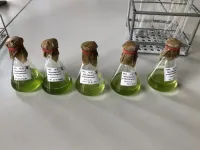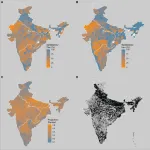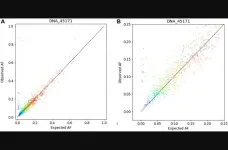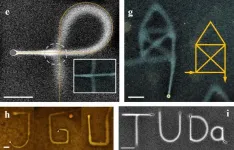(Press-News.org) A cancer diagnosis can increase the risk of infertility in young women. While consuming a healthy diet – including whole grains, fruits, vegetables, and healthy fatty acids – has been found to improve both fertility and cancer survivorship, over 90% of young adult cancer survivors don’t meet the dietary recommendations and have diets consisting of high fat and low fruit and vegetable intake. Researchers from Drexel University’s College of Nursing and Health Professions explored the barriers and ways to promote healthy diet practices among female cancer survivors with fertility challenges.
Recently published in Integrative Cancer Therapies, researchers conducted in-depth interviews with young, female cancer survivors with fertility challenges to collect information about their dietary intake and help inform the development of dietary interventions for this population.
“Clearly, barriers exist for these young women who are unable to meet healthy dietary recommendations. Yet, to date, no study has investigated nutrition-related barriers to female cancer survivors experiencing fertility challenges,” said Brandy-Joe Milliron, PhD, an associate professor in the College and corresponding author of the study.
In addition to the in-depth interviews, 20 female cancer survivors of reproductive age gave three 24-hour dietary recalls – a self-report of food and beverages they consumed the day before – to gauge the quality of their diets based on the Healthy Eating Index (2015) and how closely they adhered to the Dietary Guidelines for Americans. The researchers followed up with some participants in focus group discussions to ensure the meanings and perspectives of participants were accurate.
Overall, women in the study reported a poor-quality diet, with four main barriers to eating a healthy diet emerging from the data:
Challenges of work-life balance
Treatment-related fatigue
Dietary guidance, if provided, was too rigid for them to follow
Lack of nutrition resources and minimal guidance tailored to their unique needs during treatment and throughout post-treatment life
Despite these barriers, the research team did identify several facilitators to healthy eating, especially among participants with higher quality diets. These included building trust between patients and their health care provider, identifying a high motivation to improve nutrition-related behaviors and recognition of the additional benefits of nutrition and a healthy diet.
The research team noted that the findings are not generalizable, and future research should continue to investigate and explore the unique nutrition- and wellness-related needs of young female cancer survivors with diverse racial and ethnic, educational, and socioeconomic backgrounds and across different cancer types and treatments.
They recommend that nutrition programs and interventions for female cancer survivors use evidence-based strategies and tools such as motivational interviewing, self-monitoring, and social support. Customized interventions should accommodate women’s work schedules to improve adherence, and culinary education resources may help improve survivors’ confidence in cooking, motivation and fatigue management.
“Nutrition interventions that seek to strengthen fertility treatment can be optimized by considering and addressing barriers and facilitators during the development stage,” said Milliron.
In addition to Milliron, co-authors include lead author Cynthia Klobodu, PhD, of California State University, Chico; Jonathan Deutsch, PhD, Kathleen Fisher, PhD, Jennifer A. Nasser, PhD, and Dahlia Stott, of Drexel University; and Mara Vitolins, DrPH of Wake Forest University.
This study was supported, in part, by the American Society for Nutrition Foundation (ASNF) Predoctoral Fellowship Award and the Drexel University College of Nursing and Health Professions Dean’s PhD Student Research Award.
END
How nutrition guidance can optimize fertility treatments for female cancer survivors
Researchers found four main barriers prevented women in the study from achieving a healthy diet
2023-08-30
ELSE PRESS RELEASES FROM THIS DATE:
Algae provide clues about 600 million years of plant evolution
2023-08-30
The Earth's surface is covered by plants. They make up the majority of biomass on land and exhibit a wide range of diversity, from mosses to trees. This astounding biodiversity came into existence due to a fateful evolutionary event that happened just once: plant terrestrialization. This describes the point where one group of algae, whose modern descendants can still be studied in the lab, evolved into plants and invaded land around the world. An international group of researchers, spearheaded by a team from the University of Göttingen, generated large ...
Editorial: Epigenetic aging in oocytes
2023-08-30
“In summary, our group demonstrates basic principles in the early aging of mammalian oocytes.”
BUFFALO, NY- August 30, 2023 – A new editorial paper was published in Aging (listed by MEDLINE/PubMed as "Aging (Albany NY)" and "Aging-US" by Web of Science) Volume 15, Issue 15, entitled, “Epigenetic aging in oocytes.”
Aging-related phenotypes span many different tissues and cell types, and start to occur at different ages - a different typical age for every cell type. In their new editorial, researchers Peera Wasserzug-Pash and Michael ...
Can taking statins after a bleeding stroke lower risk of another stroke?
2023-08-30
MINNEAPOLIS – People who have had a stroke called an intracerebral hemorrhage who take cholesterol-lowering drugs called statins may have a lower risk of having another stroke, especially ischemic stroke, compared to people who also had an intracerebral hemorrhage but were not taking statins, according to a new study published in the August 30, 2023, online issue of Neurology®, the medical journal of the American Academy of Neurology.
Intracerebral hemorrhage is caused by bleeding in the brain. Ischemic stroke is caused by a blockage of blood flow to the brain and is the most common type of stroke.
“Previous research has had mixed results on the risk of ...
Stanford-led study reveals way to help prevent childhood stunting
2023-08-30
A relatively small intervention could have a huge impact on a damaging condition that stalks children in the developing world. A new Stanford-led study shows that adding zinc to farmland soil can help prevent childhood stunting, a condition due to chronic undernutrition that is associated with poor brain development and long-lasting harmful consequences, such as reduced school performance and increased disease risks. The paper, published Aug. 21 in Scientific Reports is the first large-scale study to examine the association between children’s nutritional status or health outcomes and soil mineral availability in India, ...
Validation of a comprehensive genomic profiling assay: NeXT Dx™
2023-08-30
“NeXT Dx incorporates a range of features and comprehensive genome variant detection methods that lead to improved disease management and possible enhanced clinical utility.”
BUFFALO, NY- August 30, 2023 – A new research paper was published in Oncotarget's Volume 14 on August 30, 2023, entitled, “Analytic validation of NeXT Dx™, a comprehensive genomic profiling assay.”
In this new research paper, researchers Juan-Sebastian Saldivar, Jason Harris, Erin Ayash, Manqing Hong, Prateek Tandon, Saloni Sinha, Patricia Miranda Hebron, Erin E. Houghton, ...
UC Davis names Blake Meyers as new Genome Center director
2023-08-30
Blake Meyers, a principal investigator at the Donald Danforth Plant Science Center and a professor of plant sciences from the University of Missouri - Columbia, has been named the new director and Novozymes Chair in Genomics at the UC Davis Genome Center. Meyers, who studies plant RNA biology, bioinformatics and functional genomics, will step into the role on March 1.
A member of the National Academy of Sciences, Meyers succeeds the center’s founding director Richard Michelmore, a distinguished professor in the departments of Plant Sciences, Molecular and Cellular Biology, and Medical Microbiology and Immunology.
Roots ...
NASA to demonstrate laser communications from space station
2023-08-30
NASA uses the International Space Station — a football field-sized spacecraft orbiting Earth — to learn more about living and working in space. For over 20 years, the space station has provided a unique platform for investigation and research in areas like biology, technology, agriculture, and more. It serves as a home for astronauts conducting experiments, including advancing NASA’s space communications capabilities.
In 2023, NASA is sending a technology demonstration known as the Integrated LCRD Low Earth Orbit User ...
Educational attainment protects against a genetic risk factor for Alzheimer’s disease
2023-08-30
A new study by researchers from Mass General Brigham further illustrates that when it comes to risk of Alzheimer’s disease, even genetically determined forms of the disease, genetics is only one piece of the puzzle. Researchers investigated the influence of genetics and educational attainment on cognitive decline by studying data from 675 people who carry a mutation that predisposes them to early onset Alzheimer’s disease. Carriers of this mutation—known as PSEN1 E280A—have a median age of 49 for onset of dementia. The team found that among ...
Virtual institute at the University of Kansas to combat cyber threats
2023-08-30
LAWRENCE, KANSAS — A new virtual institute established at the University of Kansas School of Engineering will train the next generation of military and civilian leaders to better combat the growing threat of cyberattacks and protect the electromagnetic spectrum (EMS).
KU received a two-year, $1.5 million grant from the Department of Defense to establish the program, known as the Virtual Institutes for Cyber and Electromagnetic Spectrum Research and Employ, or VICEROY, Virtual Institute. The grant is overseen by the Griffiss Institute, which is a nonprofit talent ...
How to write in water?
2023-08-30
Writing is an age-old cultural technique. Thousands of years ago, humans were already carving signs and symbols into stone slabs. Scripts have become far more sophisticated since then but one aspect remains the same: Whether the writer is using cuneiform or a modern alphabet, a solid substrate, such as clay or paper, is required to fix the written structures in place. However, researchers at Johannes Gutenberg University Mainz (JGU), TU Darmstadt, and Wuhan University asked themselves how to write in a bulk fluid like water without fixing substrates. The concept would not be unlike the way aircraft leave three-dimensional vapor trails behind them when they ...
LAST 30 PRESS RELEASES:
Injectable breast ‘implant’ offers alternative to traditional surgeries
Neuroscientists devise formulas to measure multilingualism
New prostate cancer trial seeks to reduce toxicity without sacrificing efficacy
Geometry shapes life
A CRISPR screen reveals many previously unrecognized genes required for brain development and a new neurodevelopmental disorder
Hot flush treatment has anti-breast cancer activity, study finds
Securing AI systems against growing cybersecurity threats
Longest observation of an active solar region
Why nail-biting, procrastination and other self-sabotaging behaviors are rooted in survival instincts
Regional variations in mechanical properties of porcine leptomeninges
Artificial empathy in therapy and healthcare: advancements in interpersonal interaction technologies
Why some brains switch gears more efficiently than others
UVA’s Jundong Li wins ICDM’S 2025 Tao Li Award for data mining, machine learning
UVA’s low-power, high-performance computer power player Mircea Stan earns National Academy of Inventors fellowship
Not playing by the rules: USU researcher explores filamentous algae dynamics in rivers
Do our body clocks influence our risk of dementia?
Anthropologists offer new evidence of bipedalism in long-debated fossil discovery
Safer receipt paper from wood
Dosage-sensitive genes suggest no whole-genome duplications in ancestral angiosperm
First ancient human herpesvirus genomes document their deep history with humans
Why Some Bacteria Survive Antibiotics and How to Stop Them - New study reveals that bacteria can survive antibiotic treatment through two fundamentally different “shutdown modes”
UCLA study links scar healing to dangerous placenta condition
CHANGE-seq-BE finds off-target changes in the genome from base editors
The Journal of Nuclear Medicine Ahead-of-Print Tip Sheet: January 2, 2026
Delayed or absent first dose of measles, mumps, and rubella vaccination
Trends in US preterm birth rates by household income and race and ethnicity
Study identifies potential biomarker linked to progression and brain inflammation in multiple sclerosis
Many mothers in Norway do not show up for postnatal check-ups
Researchers want to find out why quick clay is so unstable
Superradiant spins show teamwork at the quantum scale
[Press-News.org] How nutrition guidance can optimize fertility treatments for female cancer survivorsResearchers found four main barriers prevented women in the study from achieving a healthy diet






